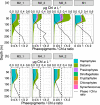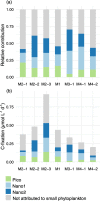Small phytoplankton contribute greatly to CO2-fixation after the diatom bloom in the Southern Ocean
- PMID: 33712701
- PMCID: PMC8397732
- DOI: 10.1038/s41396-021-00915-z
Small phytoplankton contribute greatly to CO2-fixation after the diatom bloom in the Southern Ocean
Abstract
Phytoplankton is composed of a broad-sized spectrum of phylogenetically diverse microorganisms. Assessing CO2-fixation intra- and inter-group variability is crucial in understanding how the carbon pump functions, as each group of phytoplankton may be characterized by diverse efficiencies in carbon fixation and export to the deep ocean. We measured the CO2-fixation of different groups of phytoplankton at the single-cell level around the naturally iron-fertilized Kerguelen plateau (Southern Ocean), known for intense diatoms blooms suspected to enhance CO2 sequestration. After the bloom, small cells (<20 µm) composed of phylogenetically distant taxa (prymnesiophytes, prasinophytes, and small diatoms) were growing faster (0.37 ± 0.13 and 0.22 ± 0.09 division d-1 on- and off-plateau, respectively) than larger diatoms (0.11 ± 0.14 and 0.09 ± 0.11 division d-1 on- and off-plateau, respectively), which showed heterogeneous growth and a large proportion of inactive cells (19 ± 13%). As a result, small phytoplankton contributed to a large proportion of the CO2 fixation (41-70%). The analysis of pigment vertical distribution indicated that grazing may be an important pathway of small phytoplankton export. Overall, this study highlights the need to further explore the role of small cells in CO2-fixation and export in the Southern Ocean.
© 2021. The Author(s).
Conflict of interest statement
The authors declare no competing interest.
Figures






References
-
- Longhurst A, Sathyendranath S, Platt T, Caverhill C. An estimate of global primary production in the ocean from satellite radiometer data. J Plankton Res. 1995;17:1245–71. doi: 10.1093/plankt/17.6.1245. - DOI
-
- Falkowski PG, Raven JA. Aquatic photosynthesis. Princeton, NJ: Princeton University Press; 2013.
-
- Palmer JR, Totterdell IJ. Production and export in a global ocean ecosystem model. Deep Sea Res Part Oceanogr Res Pap. 2001;48:1169–98. doi: 10.1016/S0967-0637(00)00080-7. - DOI
Publication types
MeSH terms
Substances
LinkOut - more resources
Full Text Sources
Other Literature Sources
Research Materials

